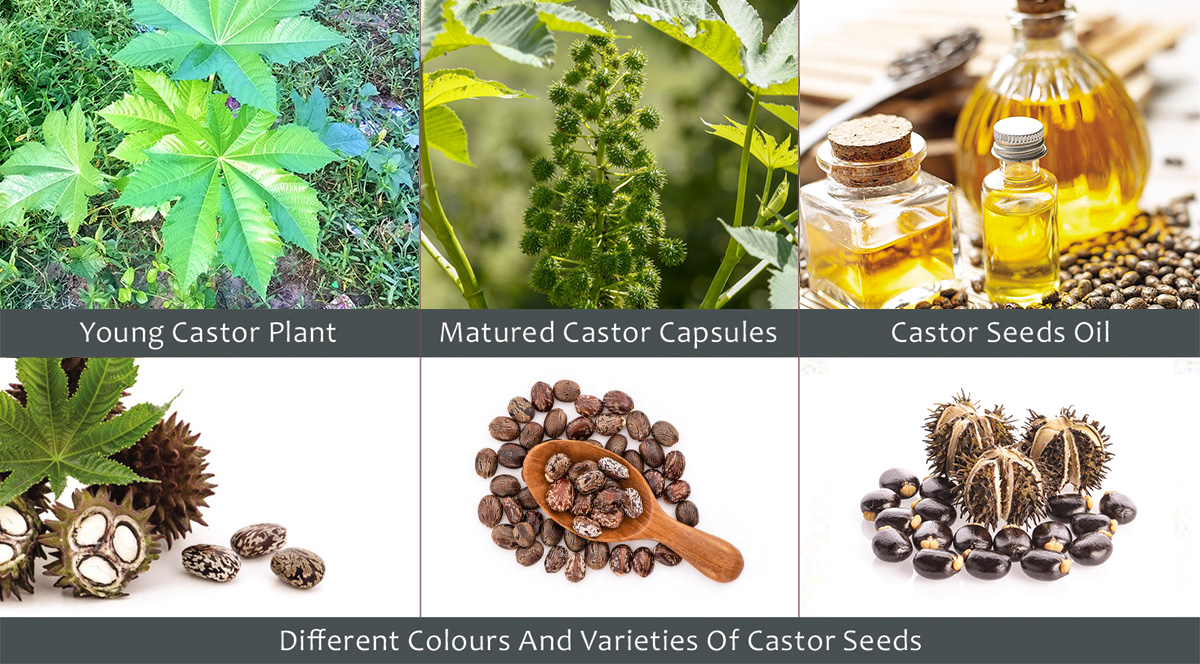- Castor – Introduction
Castor Oil is a multi-purpose vegetable oil made by extracting oil from the seeds of the Ricinus Communis plant. These seeds, which are known as castor beans, contain a toxic enzyme called ricin. Castor oil is colourless to very pale-yellow liquid with a distinct taste and odour. It has variety of uses and is primarily used in the manufacturing of Soaps, Lubricants, Hydraulic and Brake Fluids, Paints, Dyes, Coatings, Inks, Cold Resistant Plastics, Waxes and Polishes, Nylon, Pharmaceuticals, Perfumes and many such products. Growing concerns pertaining to Biofuels especially Biodiesel and Biopolymer across the globe is pushing castor oil to play a much larger role in the world economy.
Castor seeds primarily grow in tropical and subtropical climates. India is the largest producer of castor seeds in the world, followed by China and Brazil. Castor seeds contain around 48-50 % oil by weight and about 45% of this oil can be extracted with presently available technologies. For extraction, seeds must be crushed and pressed with including oxidation, hydrogenation and thermal treatments to produce products for specific applications.
- Indian Castor Scenario
India is the leader in global castor production and dominates in international castor oil trade with 92% share of total world’s castor oil production. The Indian variety of castor has an oil content of 48% out of which about 42% can be extracted while the cake retains the rest. Castor grows well in tropical conditions and the crop duration is 4-5 months. In India, it is sown in July/August and harvesting commences around January/February. The arrivals in the market start from January onwards till mid of May. The major castor growing states are Gujarat, Andhra Pradesh, Tamil Nadu, Odisha, and Rajasthan. It is also grown in the states of Uttar Pradesh, Maharashtra, Karnataka, Madhya Pradesh, and Bihar.

- Castor Seed
Total area under castor seed cultivation in India for the year 2020-21 (Apr-Mar) is estimated to be 826,120 hectares as per the government’s estimates. This was a decline of 15% compared to the previous year. The total seed production in India is estimated to be 1.902 million tons in 2020-21 against last year’s estimate of 1.953 million tons.
- Major Castor Seed Producing States
Cultivation of castor seed mainly confined to western states like Gujarat and Rajasthan which together contribute 87% to total production. Gujarat has the largest share in India production with 71% share followed by Rajasthan (16%). Statewise production of Castor is shown in the table on the right side page.
Gujarat state ranks first position in the country with respect to area and production and productivity because majority of farmers are adopting hybrid varieties and cultivating this crop as irrigated crop. Gujarat, kadi has the world’s highest castor seed yield in kilograms per hector. Important castor growing districts in Gujarat are Mehsana, Sabarkantha, Banaskantha, Kutch, Ahmedabad, Kheda, Vadodara, Rajkot, Jamnagar and Gandhinagar.
| Statewise Production Of Castor | ||||||
|---|---|---|---|---|---|---|
| States | Castor Acreage ("000" Ha) |
Castor Yield Estimates(Kg/Hectare) |
Production Estimates (in "000" Tons) |
|||
| 2019-20 | 2020-21 | 2019-20 | 2020-21 | 2019-20 | 2020-21 | |
| Gujarat | 740.60 | 638.00 | 2241.00 | 2553.00 | 1659.30 | 1629.00 |
| Rajasthan | 154.24 | 125.70 | 1598.00 | 1876.00 | 245.80 | 235.80 |
| AP Telangana | 57.35 | 38.22 | 593.00 | 589.00 | 34.55 | 22.52 |
| Others | 21.00 | 24.00 | 600.00 | 630.00 | 12.60 | 15.12 |
| India | 973.19 | 826.12 | 2006.00 | 2303.00 | 1952.25 | 1902.44 |
Important castor growing districts of Rajasthan are Barmer, Jalore, Jodhpur and Sirohi. Productivity of farms in Rajasthan has been on a rise too owing to adoption of quality or hybrid variety castor seed, favourable weather and adequate availability of water for irrigation.
The most important castor growing districts in Andhra Pradesh and Telangana are Ananthapur, Kurnool, Mahbubnagar, Wanaparthy, Gadwal.
- Global Castor Production Scenario
As of 2019-20, three countries (India, China, and Brazil) produced 93% of the world’s supply of castor oil. As production is concentrated mainly in these three countries, total castor production varies widely from year to year due to fluctuations in rainfall and the size of the area utilized for planting. As a consequence, this concentration has led to cyclic castor production. Thus, diversification of castor production regions and production under irrigation would hopefully reduce the climatic impact on castor supplies.
- Processing Of Castor Seed
Castor seed harvested from field is dried till the pods open. Seeds are hulled by using de-hullers or by hand to remove the seed from the pod. Castor seed contains about 50 percent of oil by weight and extraction of oil is done in a manner like that for most other oil seeds. The ripe seeds are allowed to dry when they split open and discharge the seeds. These seeds are cleaned, cooked, and dried prior to extraction. Cooking is done to coagulate protein (necessary to permit efficient extraction), and to free the oil for efficient pressing.
The first stage of oil extraction is pre-pressing, using a high-pressure continuous screw press – called the expeller. Extracted oil is filtered, and the material removed from the oil is fed back into the stream along with fresh material. Material finally discharged from the press, called cake, contains 8 to 10 percent oil.
| Global Castor Production (QTY in "000" tons) | ||||||
|---|---|---|---|---|---|---|
| 2020/21 | 2019/20 | 2018/19 | 2017/18 | 2016/17 | 2011/12 | |
| India | 1800 | 1970 | 1127 | 1460 | 1260 | 1950 |
| China | 17 | 36 | 26 | 32 | 37 | 160 |
| Thailand | 12 | 12 | 12 | 12 | 11 | 11 |
| Africa | 20 | 20 | 21 | 17 | 19 | 17 |
| Brazil | 43 | 31 | 20 | 13 | 15 | 141 |
| World | 1974 | 2154 | 1289 | 1615 | 1424 | 2356 |
It is crushed into a coarse meal and subjected to solvent extraction with hexane or heptane.

Oil Press Machine
- Castor Oil
The global castor oil and its derivatives market is expected to post a CAGR of over 5% during the period 2020-21. This growth is primarily owing to increase in demand from the end-use industries such as cosmetics, lubricants, and pharmaceuticals and the growing pressure for reduced petrochemicals dependence.
India is largest exporter of castor seed oil as it is largest producer of the seed. During the calendar year 2020 India’s Castor oil exports have grown remarkable resurgent and reached to record figure of about 650000 tons compared to about 545000 tons in the previous years. This is the commendable achievement and shows the strength of the industry, that even COVID-19 could not slow it down.
(to be continued in issue XXXV)